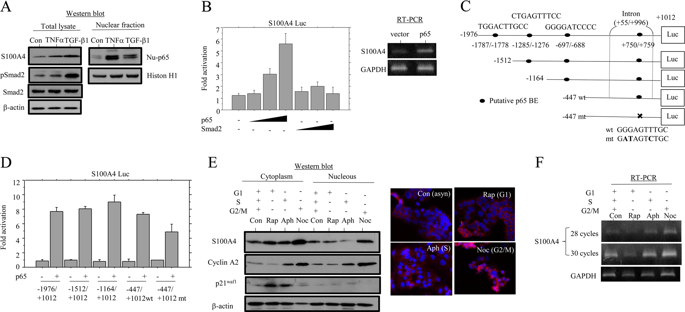当前位置:
X-MOL 学术
›
Lab. Invest.
›
论文详情
Our official English website, www.x-mol.net, welcomes your
feedback! (Note: you will need to create a separate account there.)
S100A4/non-muscle myosin II signaling regulates epithelial-mesenchymal transition and stemness in uterine carcinosarcoma.
Laboratory Investigation ( IF 5.1 ) Pub Date : 2019-12-19 , DOI: 10.1038/s41374-019-0359-x Masataka Tochimoto 1 , Yasuko Oguri 1 , Miki Hashimura 1 , Ryo Konno 2 , Toshihide Matsumoto 1 , Ako Yokoi 1 , Yoshio Kodera 2 , Makoto Saegusa 1
Laboratory Investigation ( IF 5.1 ) Pub Date : 2019-12-19 , DOI: 10.1038/s41374-019-0359-x Masataka Tochimoto 1 , Yasuko Oguri 1 , Miki Hashimura 1 , Ryo Konno 2 , Toshihide Matsumoto 1 , Ako Yokoi 1 , Yoshio Kodera 2 , Makoto Saegusa 1
Affiliation

|
Uterine carcinosarcoma (UCS) represents a true example of cancer associated with epithelial-mesenchymal transition (EMT), which exhibits cancer stem cell (CSC)-like traits. Although S100A4 is an inducer of EMT, little is known about its involvement in UCS tumorigenesis. Herein, we focused on the functional role of S100A4 during development of UCS. Expression of S100A4 and molecules associated with its function were also examined in 35 UCS cases. In endometrial carcinoma cell lines, S100A4 promoter activity and mRNA levels were significantly increased by the transfection of NF-κB/p65, independent of a putative κB-binding site in the promoter. Cells stably overexpressing S100A4 showed enhancement of CSC properties, along with decreased cell proliferation and acceleration of cell migration. These phenotypes were abrogated in S100A4-knockdown cells. A combination of S100A4 antibody-mediated co-immunoprecipitation and shotgun proteomics analysis revealed that S100A4 strongly interacted with non-muscle myosin II (NMII) heavy chains, including myosin 9 and myosin 14. Specific inhibition of NMII by blebbistatin phenocopied S100A4 overexpression and induced a fibroblast-like morphology. In clinical samples, S100A4 score was significantly higher in sarcomatous as compared with carcinomatous components of UCS, and was positively correlated with ALDH1, Slug, and vimentin scores, and inversely with Ki-67 labeling indices. These findings suggest that an S100A4/NMII-related signaling cascade may contribute to the establishment and maintenance of EMT/CSC properties, along with changes in cell proliferation and migration capability. These events may be initiated in carcinomatous components in UCS and lead to divergent sarcomatous differentiation.
中文翻译:

S100A4/非肌肉肌球蛋白 II 信号调节子宫癌肉瘤的上皮-间质转化和干性。
子宫癌肉瘤 (UCS) 代表了与上皮-间质转化 (EMT) 相关的癌症的真实例子,它表现出癌症干细胞 (CSC) 样特征。尽管 S100A4 是 EMT 的诱导剂,但对其参与 UCS 肿瘤发生的了解甚少。在此,我们重点关注 S100A4 在 UCS 开发过程中的功能作用。还在 35 个 UCS 病例中检查了 S100A4 的表达和与其功能相关的分子。在子宫内膜癌细胞系中,转染 NF-κB/p65 后 S100A4 启动子活性和 mRNA 水平显着增加,与启动子中推定的 κB 结合位点无关。稳定过表达 S100A4 的细胞显示 CSC 特性增强,同时细胞增殖减少和细胞迁移加速。这些表型在 S100A4 击倒细胞中被废除。S100A4 抗体介导的免疫共沉淀和鸟枪法蛋白质组学分析的组合表明,S100A4 与非肌肉肌球蛋白 II (NMII) 重链(包括肌球蛋白 9 和肌球蛋白 14)强烈相互作用。blebbistatin 对 NMII 的特异性抑制表型复制 S100A4 过表达并诱导成纤维细胞样形态。在临床样本中,与 UCS 的癌成分相比,肉瘤成分中的 S100A4 评分显着更高,并且与 ALDH1、Slug 和波形蛋白评分呈正相关,与 Ki-67 标记指数呈负相关。这些发现表明,S100A4/NMII 相关信号级联可能有助于 EMT/CSC 特性的建立和维持,以及细胞增殖和迁移能力的变化。
更新日期:2019-12-20
中文翻译:

S100A4/非肌肉肌球蛋白 II 信号调节子宫癌肉瘤的上皮-间质转化和干性。
子宫癌肉瘤 (UCS) 代表了与上皮-间质转化 (EMT) 相关的癌症的真实例子,它表现出癌症干细胞 (CSC) 样特征。尽管 S100A4 是 EMT 的诱导剂,但对其参与 UCS 肿瘤发生的了解甚少。在此,我们重点关注 S100A4 在 UCS 开发过程中的功能作用。还在 35 个 UCS 病例中检查了 S100A4 的表达和与其功能相关的分子。在子宫内膜癌细胞系中,转染 NF-κB/p65 后 S100A4 启动子活性和 mRNA 水平显着增加,与启动子中推定的 κB 结合位点无关。稳定过表达 S100A4 的细胞显示 CSC 特性增强,同时细胞增殖减少和细胞迁移加速。这些表型在 S100A4 击倒细胞中被废除。S100A4 抗体介导的免疫共沉淀和鸟枪法蛋白质组学分析的组合表明,S100A4 与非肌肉肌球蛋白 II (NMII) 重链(包括肌球蛋白 9 和肌球蛋白 14)强烈相互作用。blebbistatin 对 NMII 的特异性抑制表型复制 S100A4 过表达并诱导成纤维细胞样形态。在临床样本中,与 UCS 的癌成分相比,肉瘤成分中的 S100A4 评分显着更高,并且与 ALDH1、Slug 和波形蛋白评分呈正相关,与 Ki-67 标记指数呈负相关。这些发现表明,S100A4/NMII 相关信号级联可能有助于 EMT/CSC 特性的建立和维持,以及细胞增殖和迁移能力的变化。











































 京公网安备 11010802027423号
京公网安备 11010802027423号